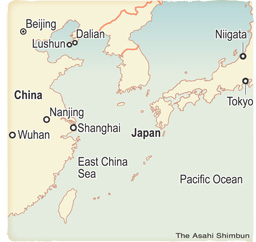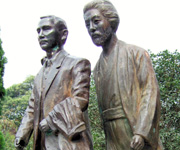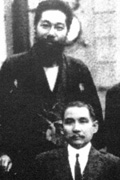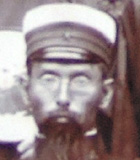Sato Kazuo
Introduction: In four years, China will be celebrating the centenary of the 1911 Revolution which toppled not only the Qing dynasty but imperial rule itself, a system that can be traced back 2,132 years when “China” was a much smaller place. In order to understand the central role played by a handful of extremely energetic (and in some cases equally eccentric) Japanese, it is helpful to consciously try to forget much of what has occurred in the intervening century, especially the two decades leading up to the Marco Polo Bridge Incident in 1937 and commencement of the Sino-Japanese War. A motley group of activist Japanese, men whose activities were not necessarily coordinated, but who felt impelled to risk their lives for the Chinese cause, early on identified Sun Yat-sen (Sun Zhongshan) as the leader to bank on and offered him their wholehearted support. Native Anglophones have for the past half-century been in the unusually lucky position of having the best book on this subject in their native tongue. This is Marius Jansen’s The Japanese and Sun Yat-sen, a book that can be read today with the same freshness as when it was first published.
As reporter Sato notes, most of these Japanese who actively worked with Sun were motivated by a pan-Asian fear of the encroaching West. Their proto-anti-imperialism, to coin a term, was the glue that linked them to one another and to Sun, despite the latter’s ongoing attachments to a variety of Westerners in the hopes of attracting money for his revolutionary cause. Best known today is the name of Miyazaki Toten who at age 33 (East Asian style) composed his famous diary, Sanjusan nen no yume (My Thirty-Three Year Dream), still one of the indispensable sources on Sun and the 1911 Revolution. We are fortunate to have this diary in English translation by Jansen and Eto Shinkichi, and a reading of it reveals much more than bombs and uprisings and the like. We learn a lot about Miyazaki and why his family may have been as impoverished as his granddaughter reports to Sato–he was squandering money on alcohol and geishas with reckless abandon. He wrote the diary in the early years of the 20th century, when the Chinese revolutionary movement was at a very low tide with Sun in the midst of a long exile, and it was supposed to recount his continued failures and, to be frank, self-pity–hence, a lifetime of unrealistic dreaming.
Jansen begins his book on Sun Yat-sen in 1929 when his remains were being reinterred at their present site in Nanjing, and he looks at the Japanese in attendance at the moment, Inukai Tsuyoshi among them. Only three years later Inukai, while serving as Japan’s prime minister, would be murdered by rightwing terrorists, one of whose leaders was with him on that day in 1929. The point is that the anti-imperialism that spurred young men to support Sun and the Chinese revolution had several inchoate sides a century ago and those political differences would not become manifest until several decades later.
Reading press reports of problems in contemporary Sino-Japanese relations, be they political or economic, the first thing one tends to think of is the truly horrific decades of the 1930s and 1940s. It is well to occasionally remember that better times prevailed at the turn of the last century–not so as to forget those harsher times but as a basis for establishing firmer ground from which to move forward.
Links to Japan run deep
About a century ago, the wheel of history took a major turn with the Xinhai Revolution in China. The dynastic government stretching back more than 2,000 years was overthrown, which led to Asia’s first republic.
The revolution had strong Japanese connections because many of the movement’s leaders were educated in Japan and received Japanese support. Meanwhile, there were already rumblings emanating from the Imperial Japanese Army that wanted to capitalize on the rising tide of revolutionary turmoil with an eye on northeastern China (the former Manchuria).
It was raining at night in Beijing a few hours after Abe Shinzo, Japan’s first prime minister to be born after the end of World War II, abruptly announced his resignation in Tokyo. It was Sept. 12 and I was sitting in my hotel room near Tiananmen Square, blankly watching a long report on China Central Television about candidates vying to become Japan’s next prime minister.
Toward the end of the program, a facilitator asked commentators what they thought about future relations between China and Japan. One scholar said he believed that basic relations would remain the same because the two countries were increasingly becoming interdependent economically. Yet, Japanese face a psychological issue in how to deal with a rising China, he added.
A “psychological” issue? I asked myself. Surely, I thought, that leads to the question of how to view China and what sort of relations we should have.
Around the time of the Xinhai Revolution of 1911 roughly a century ago, Japan faced the same question in a different context. What kind of answer were Japanese trying to find back then? I decided to follow the path of two Japanese who were deeply involved in the revolution.
Throughout his life, Miyazaki Toten strongly believed that to resist incursions by the United States and European powers, China needed to become a strong nation and he supported the revolutionary Sun Yat-sen. There were no such thoughts as “interests in mainland China” or “Japanese expansion” in Miyazaki’s mind. Many Japanese who supported Sun were nationalists who were fixated on interests in China, and who were later called rightists. Yet, Miyazaki was different. In that sense, he was an exceptional individual.
How Chinese people feel about the role he played is demonstrated in the Nanjing Historical Remains Museum of Chinese Modern History. The building was used as the provisional presidential palace for Sun after the Xinhai Revolution, and his office and living quarters are preserved as they were in his time. It can be thought of as a Sun memorial hall. Buses disgorge more than 2 million tourists to the museum each year.
In the courtyard, four small bronze statues stand on plinths about 1 meter high. One of them depicts Miyazaki walking alongside Sun and close to it is a statue of Homer Lea, an American who advised Sun on military matters. The statues bear the Chinese characters for “sincere friendship.”
“Important events for Sun Yat-sen are depicted in those four statues,” said Liu Xiaoning, vice curator of the museum, who guided me on the tour. “These statues are of his friends who supported his revolution throughout their lives. He had many Japanese friends, but Miyazaki Toten was the one who provided the most support during the early stages of the revolution.”
Certainly without Miyazaki, Sun’s revolutionary movement would have followed a more difficult path. About 110 years ago, Sun quietly entered Japan on the run from the Qing government. When Miyazaki encountered Sun, he realized this was a man who could actually change China. Miyazaki introduced Sun to Inukai Tsuyoshi and other key Japanese politicians, paving the way for Sun to operate from Japan. Furthermore, Miyazaki helped establish the Chinese Tongmenghui (United League) in Tokyo in 1905, which became a turning point in the revolutionary movement.
The Tongmenghui was formed by merging various Chinese revolutionary groups in Tokyo. Wang Xiaoqiu, a professor at Peking University, explains that the establishment of the Tongmenghui can be viewed as the beginning of the Xinhai Revolution. “Through the formation of the group, its leadership, code of operating and organizational abilities were established,” he said. “That provided the foundation for the Xinhai Revolution.”
Dedication to revolution
What kind of man was Miyazaki?
The house in which he spent his later years still stands in Tokyo’s Nishi Ikebukuro district. Several pine trees that he planted in the garden now tower over neighboring houses.
“He was such a dynamic man,” said 82-year-old Miyazaki Fuki, Miyazaki’s granddaughter. “I shouldn’t say that he didn’t take care of his family properly, but whenever he came into any money, he spent it all on promoting the revolution,” she said. “So the family lived in extreme poverty.”
She talked about various episodes she had gleaned from Miyazaki’s wife Tsuchiko and his son Ryusuke, Fuki’s father.
When Ryusuke attended the institution that later became a part of the University of Tokyo, he could not afford to buy a cape, which his fellow students wore. Eventually, he was given one. He was surprised by the gift but quickly realized what it was intended for: to hide explosives.
She also said that when Sun stayed at Miyazaki’s house, Chinese counter-revolutionary agents came knocking. Tsuchiko quickly realized the danger they were in and shooed Sun and Ryusuke out through the back door. As the two were killing time at a nearby shrine, Halley’s comet traversed the night sky. Sun turned to Ryusuke and remarked, “This is a sign that the revolution will be successful.”
Still, a question still lingers. Why was Miyazaki so devoted to supporting the Chinese revolution?
“Miyazaki believed in democratic rights and his goal was social equality,” explained Kubota Bunji, dean of the Faculty of Global Policy Management and Communications at Yamanashi Prefectural University, who has spent years studying the Xinhai Revolution. “To promote social reform in Japan, he tried to help China achieve revolution and modernization to block incursions by the United States and European nations. He was hoping to maintain Japanese independence and promote reforms in Japan as well as the rest of the world through the revolution in China.”
Unofficial mission
At this juncture, I think it’s appropriate to introduce another Japanese revolutionary. Kaneko Shintaro was born in Noda Village, Niigata Prefecture (now part of Kashiwazaki). He joined the Chinese revolutionary army immediately after the Xinhai Revolution and was later killed in battle.
Kaneko was an infantry captain well-versed in Chinese affairs. He was once invited by the Qing government to teach at a military academy. After the Russo-Japanese War, he went into the reserves and served as mayor of Noda. Shortly after he finished his term, an uprising occurred in Wuchang (now Wuchang district in Wuhan City). Before long, he left his village without saying a word to his family.
Kinebuchi Takeji, a Kashiwazaki resident who has been studying local history, researched Kaneko’s era and completed a thesis in 1974. Around that time, he came across letters and reports in local newspapers that shed new light on his subject.
In letters Kaneko sent from China to his wife, he told her that he would use four aliases, adding that they would likely meet again if he accomplished his goals. Otherwise, he implored her to consider him as a silent force behind the scenes, or even as being dead. Kinebuchi suspected that Kaneko wanted to go to China when he learned about the uprising and joined the revolutionary army with a secret mission for the Japanese army.
Learning about a relative of Kaneko’s from Kinebuchi, I went to Nagaoka in Niigata Prefecture.
“I heard that he joined Sun Yat-sen’s revolution,” said Kaneko’s grandson Kazumasa Omiya as he flipped through a photo album Kaneko had kept. “I was told that while there was no official military order, he went to China at the behest of a high-profile individual.”
Who was the “high-profile individual” and why did he send Kaneko? Kaneko’s name sank into the darkness of history with key questions unanswered.
Independent states eyed
My encounter with materials to solve the riddle was nothing but sheer coincidence. It came while I was reading Utsunomiya Taro ‘s diary, which was published this past April. When the Xinhai Revolution erupted, Utsunomiya was an army major general and second division chief in charge of intelligence for the General Staff Office.
Here are some of Utsunomiya’s diary entries:
“Saturday, Nov. 4. Summoned Koyama Shusaku, asked him about second reserve infantry captain Kaneko Shintaro, who is eager to go to the Qing Dynasty. Decided to send him to Qing to join the revolutionary army (at my personal request), and asked Koyama to arrange for Kaneko to visit my house tomorrow morning.”
“Sunday, Nov. 5. Kaneko Shintaro visited my home early in the morning. I outlined my view that it was necessary to block the south and the north to conclude a peace and build one or more countries in the south. Gave him 2,000 yen to go to Qing. He left, thinking to initially join the revolutionary forces in Wuchang.”
Upon personally meeting Kaneko, Utsunomiya decided to dispatch him to the revolutionary forces as part of his personal mission. Utsunomiya instructed him to impede the Qing government and the revolutionary army from signing a peace treaty, and help establish an independent country in southern China that was under the influence of the revolutionary forces and covered his expenses. In effect, Utsunomiya privately deployed the soldier without the involvement of the government or army leaders.
What kinds of “personal views” did Utsunomiya share with Kaneko?
Five days after the revolution started in Wuchang, Utsunomiya awoke in the early hours and hastily jotted down policies for China that had been on his mind so he could get the General Staff Office to work on his plan.
His strategy had four main points:
•Because it was difficult to control China as a whole, it would be ideal to split it into several independent states to “save” the territory;
•After the ongoing civil strife, it was possible China could split into two states run by the Manchu and Han races;
•To be seen helping the Qing Dynasty while secretly supporting the revolutionary forces, and reconciling them at the appropriate time in a manner so as to split the country into two nations; and
•To establish special relations with each as a protectorate or ally.
The impetus for this was the so-called Manchurian and Inner Mongolian issue of Japan’s goal of permanently retaining leased territories in Dalian and Lushun, and its control of the South Manchurian Railway it gained through the Russo-Japanese War.
As the first infantry adviser, Kaneko led the revolutionary forces. But the battle in Wuhan was bitterly contested and the Qing government’s forces made a strong comeback. The revolutionary troops were defeated with a loss of about 1,000 lives. Among them was the 47-year-old Kaneko. In February 1913, Utsunomiya visited Hanyang (now Hanyang district in Wuhan City), chose a venue to honor Kaneko, and left brandy as a token. I walked around Hanyang searching for the spot, but was unsuccessful.
In the end, Utsunomiya’s China policies were not adopted by the government. The government at that time focused on cooperating with the United States and Britain and shied away from adventurous strategies. While he was unhappy with the way things turned out, Utsunomiya obeyed the government’s decisions.
However, when the revolution entered a turbulent period, the Japanese army sent many military officers to China to gather information so it could formulate its own policies regarding this vast region. The idea of having Manchuria become an independent nation, and settle the Manchurian and Inner Mongolian issue at the same time was also passed down like embers buried in ashes.
Utsunomiya Taro (1861-1922)
Born in the Saga Domain. He was an elite member of the army who graduated from the Military Academy and the Army War College. He worked mainly in the intelligence division of the General Staff Office. He was one of the leading Choshu Domain opponents in the army. He won a pledge from Iwasaki Hisaya, head of the Mitsubishi conglomerate, to provide 100,000 yen (the equivalent of several hundred million yen today) for expenses related to intelligence and espionage operations in relation to the Xinhai Revolution. He also was in close contact with Inukai Tsuyoshi, who later became prime minister, and gave him 10,000 yen when he traveled to China. At the time of the March 1 independence movement in Korea in 1919, he was commander of the Japanese army there.
Utsunomiya’s first son was the late Utsunomiya Tokuma, who was a member of the Upper House and tackled issues of arms control and friendship with China and South Korea.
Miyazaki Toten (1871-1922)
Born in Kumamoto Prefecture. Strongly influenced by the concept of democratic rights, he scrambled to support the Chinese revolution along with his elder brother Yazo. He introduced Sun Yat-sen in a series of newspaper columns called “33-Year Dream” in 1902, connecting him with revolutionaries in Japan and China. Miyazaki was a ronin who never assumed a government post throughout his life but often wrote for newspapers and magazines. In his later years, he became a traditional rokyoku storyteller, but he seems to have been a poor performer, according to granddaughter Fuki. When Mao Zedong was a young man, he once asked Miyazaki to deliver a lecture. Taught by his mother that the ultimate disgrace for a man is to die on tatami mats, he had an eventful life.
Sun Yat-sen (1866-1925)
Chinese revolutionary and politician. He founded the Kuomintang and developed the Three Principles of the People: nationalism, democracy, and the people’s livelihood, a philosophy to lead the revolution. Sun is still revered across China today, and on the 140th anniversary of his birth in 2006, President Hu Jintao praised Sun as an outstanding patriot, a national hero and forerunner of China’s democratic revolution.
When Sun was 13, he went to Hawaii where his eldest brother had found success after immigrating there, and returned home at 18. After studying medicine, he founded the secret revolutionary organization Revive China Society in Hawaii in 1894, and plotted his first armed uprising the following year, but failed. He lived in Japan in exile. According to Li Tingjiang, a professor at Chuo University, Sun visited Japan on 14 occasions and spent a total of nearly 10 years in this country.
Fact File: Xinhai Revolution
After the Boxer Rebellion in 1900, Han intellectuals began to believe that using armed revolution to overthrow the Qing Dynasty controlled by Manchu Chinese was the best way to restore the nation.
Such revolutionary groups established the Chinese Tongmenghui or United League in August 1905 in Tokyo, and attempted military actions in various places in China. On Oct. 10, 1911, some military units in Wuchang under the influence of the Tongmenghui rose in revolt.
The action quickly spread to other areas south of the Yangtze River, and revolutionaries established a provisional government in Nanjing. On Jan. 1, 1912, a revolutionary government was established with Sun Yat-sen as the provisional president and the country was named the Republic of China.
Meanwhile, the Qing Dynasty brought military official Yuan Shikai out of retirement in an attempt to bring the revolutionary army under control.
However, Yuan orchestrated a peace treaty through arbitration by Britain. As a result, Emperor Pu Yi abdicated on Feb. 12, 1912. On March 10, Yuan succeeded Sun as provisional president.
The revolution’s name arose because 1911 fell in the Xinhai year in the Chinese calendar.
This is a slightly edited version of an article that appeared in the International Herald Tribune/Asahi Shinbun on October 29,2007. Posted at Japan Focus on November 23, 2007.
Joshua Fogel is Professor of history, York University, Toronto and a Japan Focus associate.









